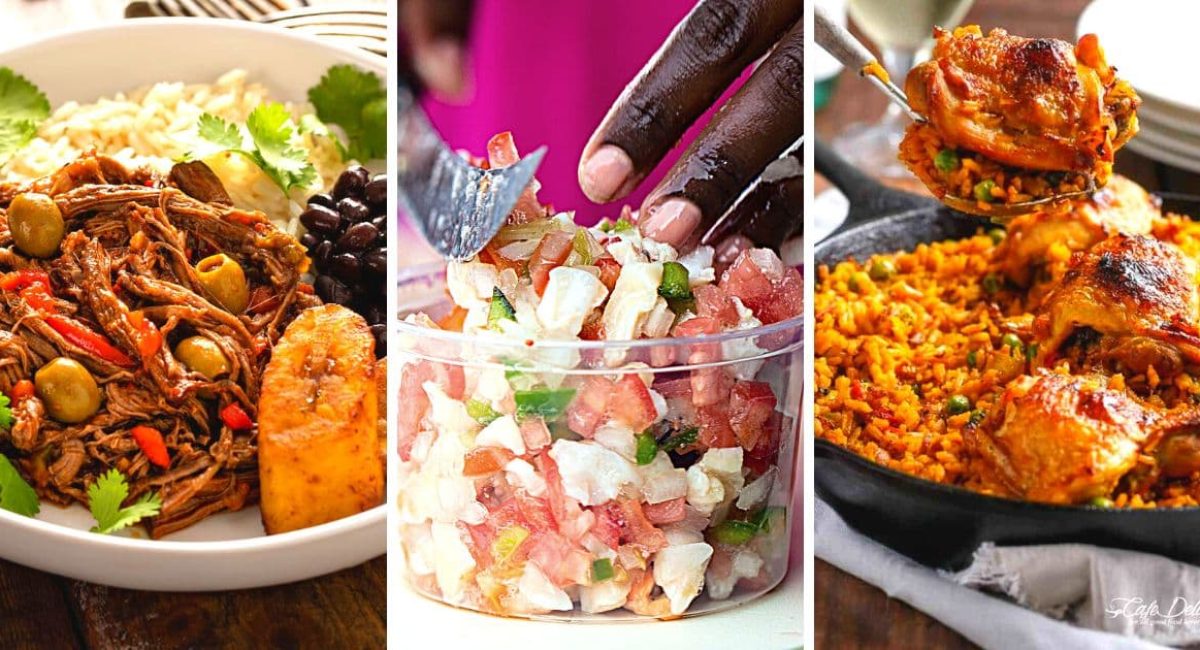This site contains affiliate links to products. We may receive a commission for purchases made through these links.
By: Paige Andrade
When you’re traveling to the Caribbean, you’ll naturally want to try some of the local favorites. But many signature Caribbean foods can be tough to replicate, with home chefs and restauranteurs taking bits from different influences, much like the islands do. That’s because Caribbean cuisine mixes foods from many cultures. There’s African, of course, along with dashes of Creole and Cajun. Stir in some European, Amerindian, East and North Indian flavors, then sprinkle in Latin American, Middle Eastern, and Chinese flair.
That might sound like a hodgepodge, but all these distinct flavors somehow meld together, creating a Caribbean cuisine known for its unique flavor pairings and globalized palate. All these different cultures create a world-class community of concept dishes and reimagined classics, each with ethnic and individual flavors that vary from Jamaica to Barbados, Trinidad to the Bahamas, and the Dominican Republic to Cuba.
This area’s rich culinary heritage thrives on fresh fish and produce, plus distinctive seasonings, such as nutmeg, cloves, cinnamon, allspice berries, paprika, ginger, turmeric, thyme, and scotch bonnet peppers. Staples include curry, flatbread, rice and peas (also known as rice and beans), and callaloo — a veggie-based dish often made with amaranth leaves. Hearty stews include goat and other meats. Seafood favorites include shrimp, conch, fresh fish, and saltfish. Coconut milk, used in coconut rice, is luscious and sweet, as are fried plantains, and fruits such as guava, passionfruit, mango, papaya, pineapple, and banana burst with intense texture and flavor.
This area that looks like paradise often tastes like one, too! Book your next unforgettable experience on Tripadvisor, with flexible bookings and free cancellations.
Instead of recommending individual Black-owned restaurants, we’re highlighting our favorite local dishes so you can explore the flavors of the Caribbean however you like. Look for them on chef specials for brunch, lunch, and dinner; while you’re out cruising the nightlife; enjoying a bite by the pool or on the beach; or taking in live music and craft cocktails.

Jamaican literary scholar Carolyn Cooper calls jerk “one of the enduring legacies of the fusion of African and Taíno cultures in Jamaica,” the Taíno being members of the indigenous population. The term jerk refers to how meat is seasoned, grilled, and smoked, transforming tough cuts of inexpensive meat into tender delights. Jerk chicken has plenty of variations, turning up at roadside stands as well as upscale restaurants. The key to its rich flavor is its spicy marinade of spring onions, garlic, scotch bonnet chilies, ginger, thyme, brown sugar, soy sauce, lime juice, allspice, and vegetable oil. This creates a thick, puckering mixture that a good chef will let absorb into the chicken overnight. Jamaican jerk chicken is traditionally smoked over pimento wood, but adding wood chips to a barbecue and cooking over slow, indirect heat also ramps up the authentic flavor. For the perfect sides, team it with coconut basmati rice and kidney beans (which a Caribbean menu calls peas).
Where the locals eat: Holy Smokes Grill & Chill
12 Waterloo Rd, Kingston, Jamaica

Call them street food. Call them a vegan snack. Neither does justice to what the BBC once called a “punchy taste experience” that “perfectly balances sweet, tart, and spicy in one addictive little package.” Doubles are a sandwich made from soft flatbread, tender curried chickpeas, and condiments that include cucumber, sauces of tamarind and coriander, and kuchela (a spicy, green mango chutney). Islanders munch on these vegetarian treats pretty much anytime, whether picking up doubles on their way to school or work in the morning or snagging them for a late-night bite before the clubs close. In 2012, during 27 hours of continuous debate, Trinidad’s parliament even recessed for a doubles break. Doubles have ties to Indian food but also speak to the locals’ creativity and perseverance, bringing their native cultures to the islands.
Where the locals eat: C&S Pies and Doubles
Western Main Road, St James, Port of Spain, Trinidad
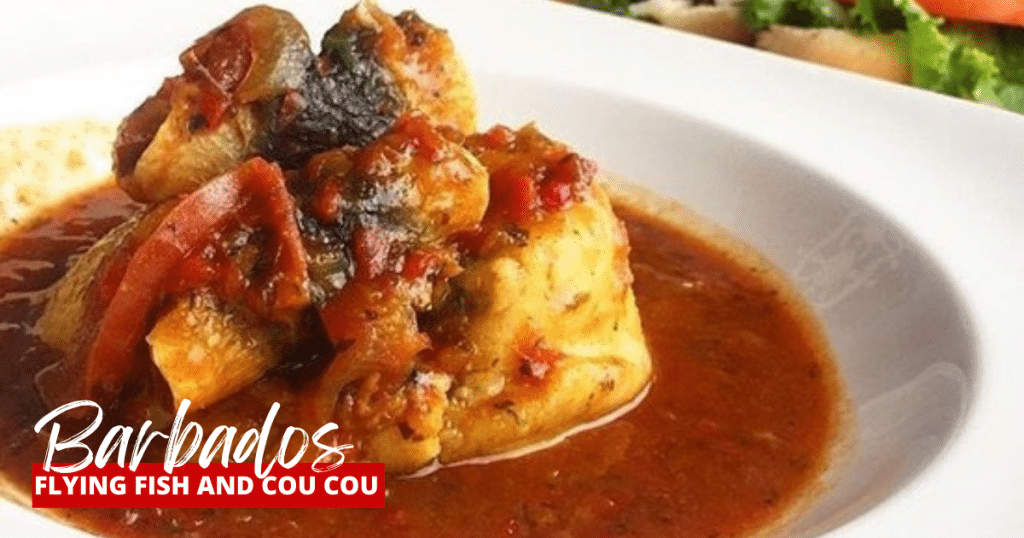
Flying fish abound around Barbados — it’s known as “the land of the flying fish” — so it’s no wonder they feature in the island’s national dish. (Incidentally, if you’ve never seen these little marine wonders, they don’t so much fly like birds but leap out of the water and glide on long, winglike fins for about 40 seconds or so. They often land accidentally on the decks of small boats.) Flying fish fillets marinate overnight in fresh lime juice and salt, then are coated in spices and seasoned breadcrumbs and fried in canola oil. Once golden brown, they’re served with a cornmeal-and-okra-based dish called cou cou, which some other Caribbean islands call by other names, such as fungi. This dish became popular because of its inexpensive ingredients, but it’s flavorful and substantial, too. The best cou cou uses fine cornmeal and thinly sliced okra and is cooked until firm but not stiff. A chef often will create an indentation in the center of the cou cou, then heap it full of the fish and other vegetables.
Where the locals eat: Cuzz’s Fish Stand
39JR+R6P Pebbles Beach, Bridgetown, Barbados
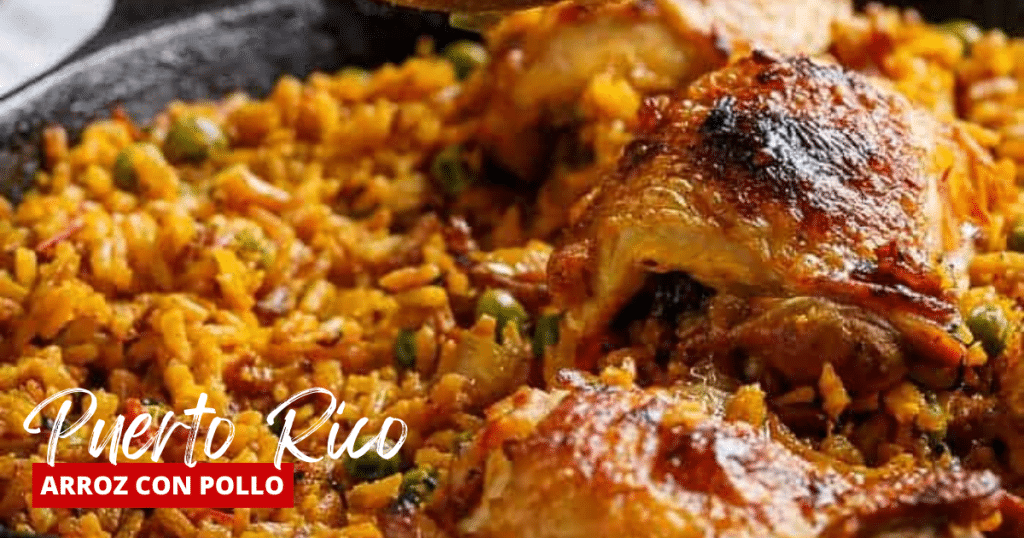
Arroz con pollo translates to chicken with rice, but this popular Puerto Rican dish varies from chef to chef. Some will add salted pork or cooked ham chopped into bite-size pieces to the rice. Regardless, it’s cooked in one pan or pot with traditional flavors such as sazon, adobo, and sofrito (cilantro, onion, and green bell pepper). This dish starts with boneless, skinless chicken thighs marinated in adobo and olive oil for at least 30 minutes. After browning the chicken in a skillet, add garlic, jalapeño, and sofrito. Stir in tomato sauce and sazon (a mixture of ground coriander, ground cumin, dried oregano, salt, garlic powder, and ground annatto seeds, which are native to South and Central America). Then simmer and fold in basmati rice and green pigeon peas. Delicioso!
Must Try Restaurant: El Mofongo Ahogao
Av. Tte. César Luis González # 574, San Juan, 00918, Puerto Rico
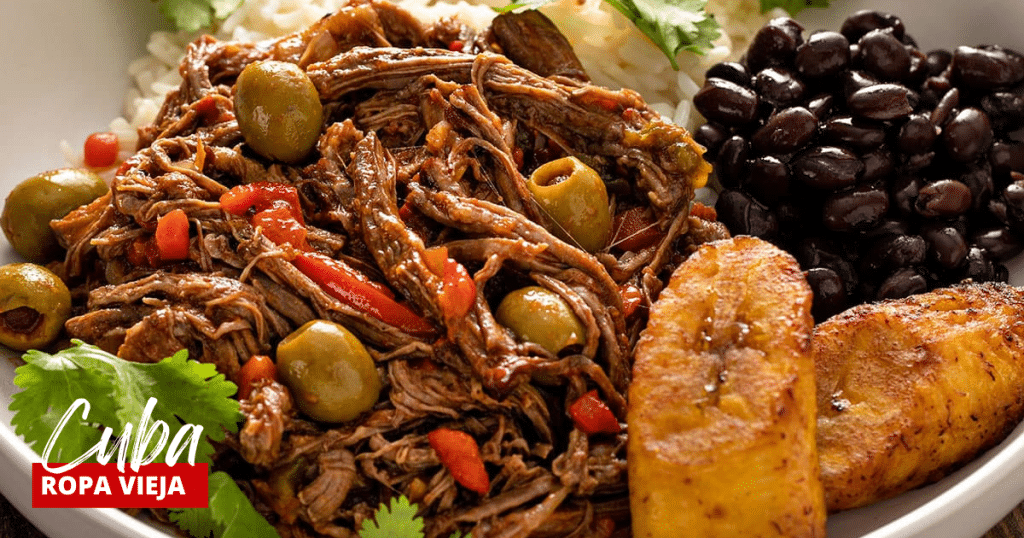
Ropa vieja translates to old clothes — a name linked to the tale of a man who couldn’t afford food for his family and decided to shred and cook his old clothes. The story says that once he prayed over this “stew,” it transformed into the rich, tasty meat dish we know today. The original recipe actually dates back more than 500 years to Sephardic Jews in Spain’s Iberian peninsula; because they couldn’t cook on the Sabbath, they put together a stew that would slow-cook the night before. Once the dish traveled with the Spanish to the Americas, it soon became a staple in the Caribbean, especially in Cuba. Ropa vieja is fairly simple but packs a lot of flavors. It starts with beef flank steak seared until browned, then cooked for hours in beef broth, tomato sauce, and tomato paste seasoned with green bell pepper, onion, garlic, cumin, cilantro, olive oil, and white vinegar. All that slow heat makes the meat practically fall apart, and it easily shreds with two forks. You’ll often find ropa vieja served with rice and beans or on tortillas with sides of cheese, fresh cilantro, and sour cream.
Where the locals eat: Doña Eutimia
Callejón del Chorro # 60 C, Plaza de la Catedral, Old Havana, Cuba
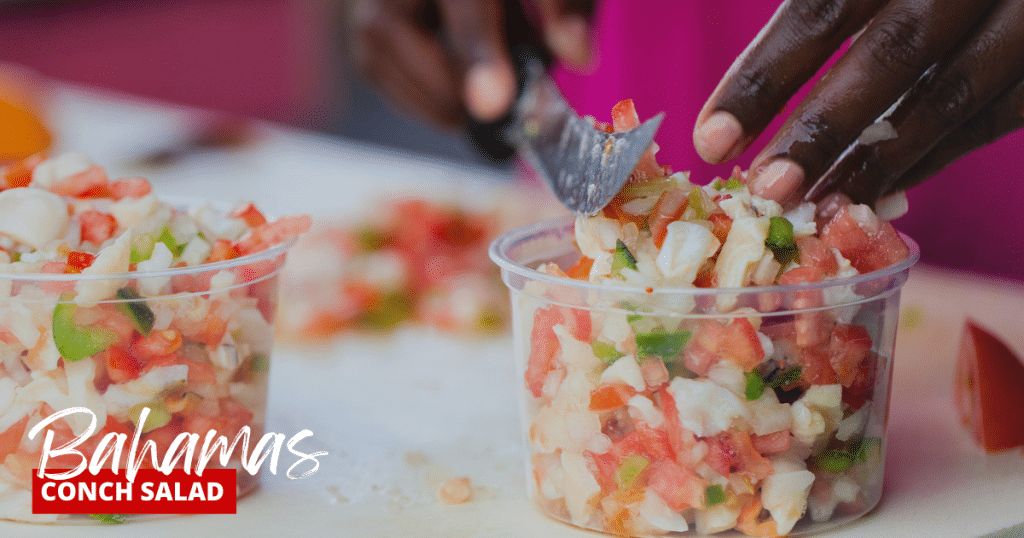
Bahamian cuisine prominently features succulent seafood, including crab, shellfish, and lobster. But the island’s national food is conch (pronounced conk), a medium to large mollusk (or sea snail) in a pink and orange shell. Conch meat turns up throughout the Bahamas — deep-fried, baked in fritters, raw, and in salads. Conch salad is a colorful, refreshing salad made with diced conch, tomato, bell peppers, jalapeños, cucumber, and onion. A common recipe calls for mixing the ingredients with fresh lime juice and fresh orange juice for up to two hours; the longer the marinade, the punchier the flavors and the more tender the conch. (Think of the tanginess of ceviche.) Other chefs might add avocado for creaminess and pineapple or mango for tropical flair.
Where the locals eat: Oh Andros
3JHR+XH9, Nassau, Bahamas
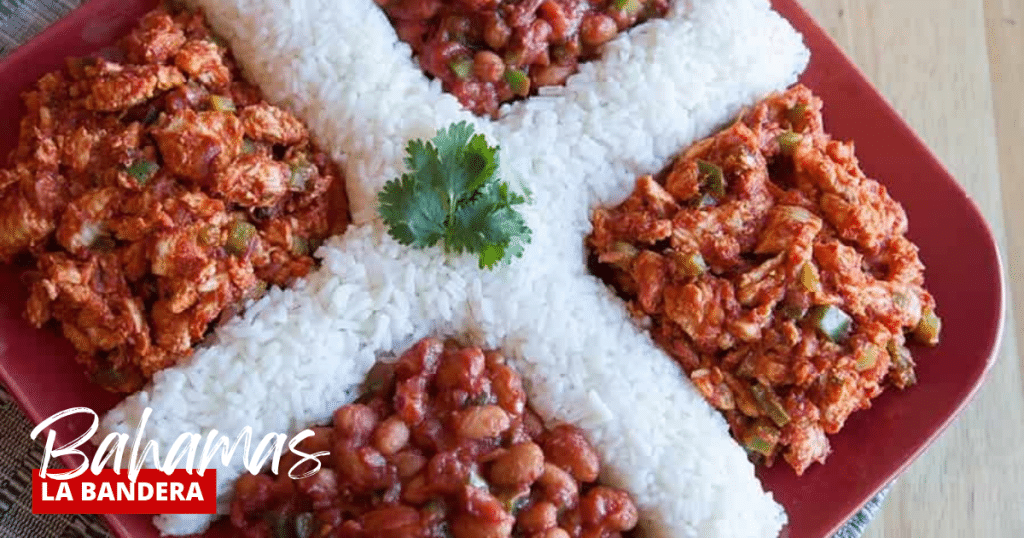
Dominican Republic: La Bandera
La Bandera Dominicana is one of the most famous foods from the Dominican Republic and literally translates to The Dominican flag. This traditional meal consists of meat (usually inexpensive chicken, but also beef, pork, or goat), rice, and red beans. Inspired by Spanish, African, and indigenous Taíno cuisine, it uses roasted or stewed meat in a sauce of tomatoes and onions. The rice usually has a concon, or a crispy, golden layer; the beans are also cooked in a savory tomato sauce with garlic, celery, onions, herbs, plantains, and squash. Some sources say that this dish dates back to the 1840s when the Dominicans declared their independence from Haiti and that the red beans represent the blood of the heroes, the white rice represents salvation, and the meat represents liberty. It’s certainly a full-bodied meal, usually served with a salad and a side dish such as corn fritters, fried green plantains, or fried eggplant.
Where the locals eat: El Conuco
C. Casimiro de Moya #152, Santo Domingo, Dominican Republic
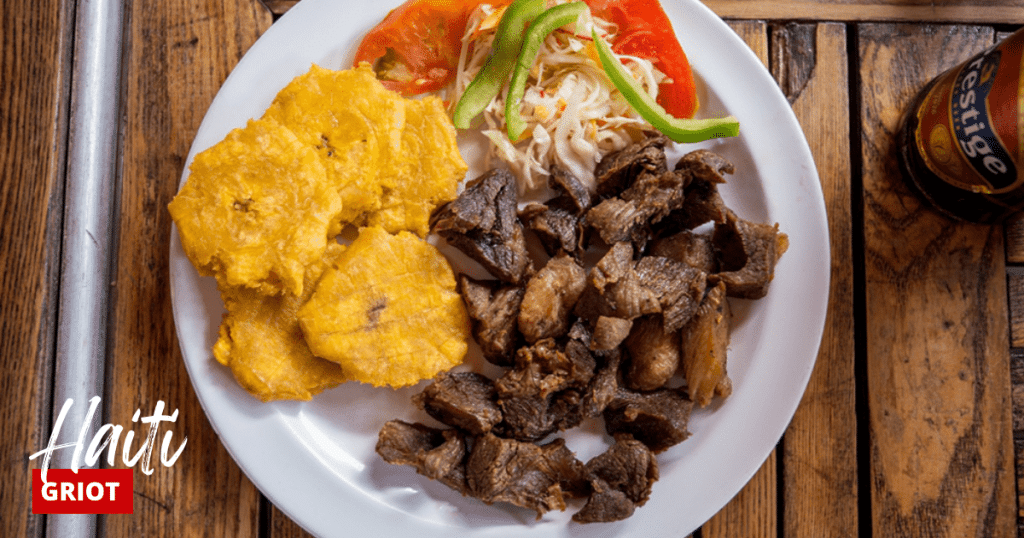
Made of pork shoulder pieces that are marinated, cooked, and fried until crispy, griot is great as a main dish but also works well as an appetizer. Once tenderized with lime juice, salt, and white vinegar, the pork is marinated for at least two hours in epis (a Haitian seasoning base that includes green onions, bell peppers, thyme, and parsley), chili pepper, and maggi cubes, a type of bouillon made with cloves, corn starch, palm oil, onion, pepper, chili, and salt. The chef cooks the meat on the stove until it’s fork-tender, then fries it in oil. Foodies say the dish’s name refers to a person of high social status, such as a diplomat, teacher, or warrior, in West African countries; because pork was scarce and expensive, local chefs usually made griot only for festive events and special occasions. Today griot is often considered Haiti’s national dish. Its sweet, tangy, and spicy flavors team well with fried plantains and pikliz, a mix of pickled vegetables that includes peppers, carrots, and cabbage.
Where the locals eat: Les Jardins du Mupanah
Avenue de la Republique, Place des Héroes de l’independance, Champs-de-Mars, 10 Ave M.Ambroise, Port-au-Prince, Haiti
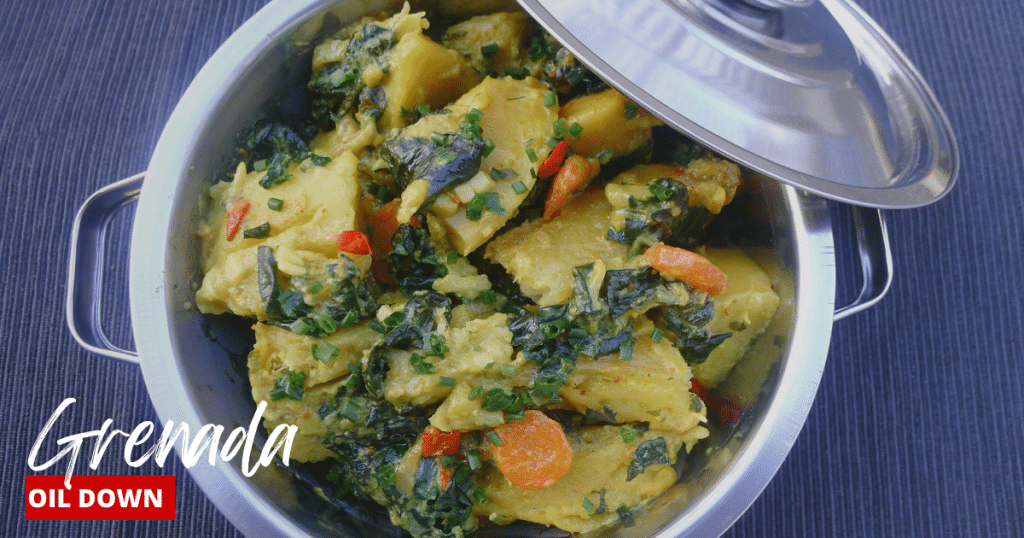
Oil Down is Grenada’s national dish, a combination of salted meat or fish steamed with dumplings, vegetables, seasonings, and coconut milk — but it also refers to the party where someone might invite you to be part of the process of preparing it. A true oil down evokes a spirit of camaraderie as everyone pitches in to tend to the fire, chop vegetables, mix drinks, and more. One recipe calls for boiled pigtails and chicken wings marinated in green seasoning (including pimento peppers and broad-leaf thyme). After adding the chicken and marinade to the bottom of a large pot, layer the pigtails on top; then add one large breadfruit cut into sections, green bananas, carrots, pumpkin, and okra. Cover the whole contents with a mixture of ground turmeric and coconut milk. Lastly, put greens such as callaloo on top. Depending on the recipe, this can cook for 25 minutes or more; before the cooking is done, a chef often will add dumplings made from a simple flour, salt, and water mixture to the top of the pot for the last few minutes.
Where the locals eat: BB’s Crabback
Grand Etang Road, St George’s, Grenada
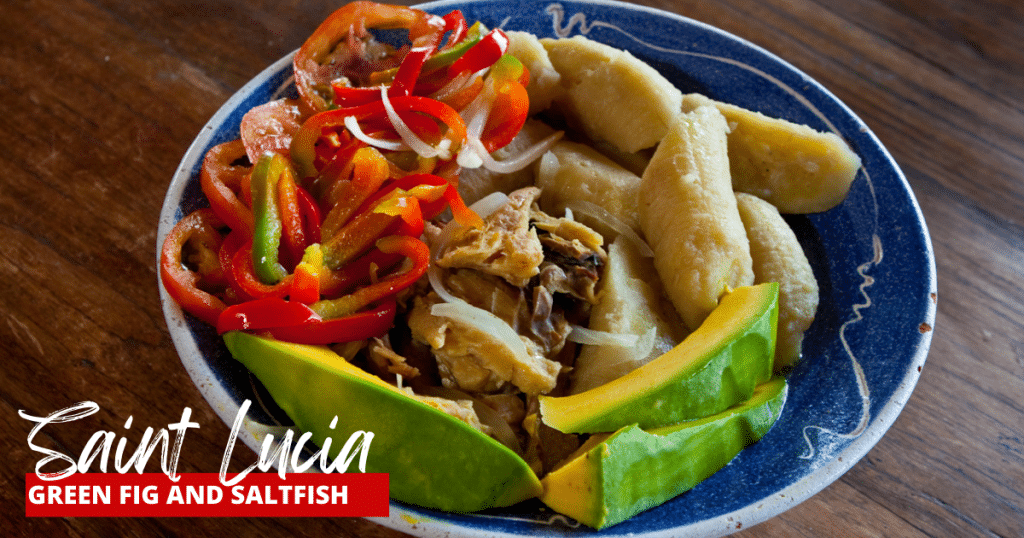
Saint Lucia: Green Fig and Saltfish
Santa Lucia’s national dish has its roots in the nineteenth century when green bananas (the green fig of this recipe) were plentiful, and salted codfish was an inexpensive import from Canada. It often turns up at the Creole Day Festival each October. To make it, a chef will slice and peel the bananas and boil them in salted water with oil until tender. The saltfish goes into another pot of boiling water for about 15 minutes to remove excess salt. Once the chef cleans the saltfish, removing bones, scales, and viscera, they’ll flake the fish and sauté it with peppers, onions, thyme, chives, and garlic. To serve, plate portions of the bananas, top generously with the saltfish, and garnish with parsley.
Where the locals eat: Martha’s Tables
WRQ+29R, Unnamed Rd, Belle Vue, St. Lucia
As you can see, each island offers luxurious flavors that are as varied as they are delicious. As you travel to the islands, explore how different chefs draw on the legacy of these dishes to create their own tastes. Caribbean food is all about fusion, building on the wealth of heritage and culture in these islands where people for decades have taken plentiful local foods and followed their creativity to make something all their own. Let their spirit inspire you as you sample the island flavors. You’re bound to have some memorable experiences along with fantastic meals.
Author: Black Restaurant Week
Content Team

